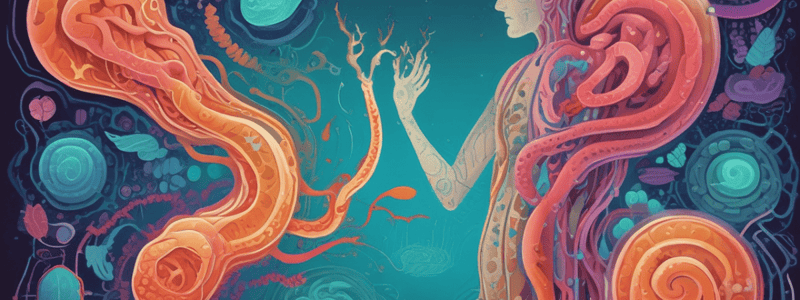Podcast
Questions and Answers
Match the following Hepatitis types with their transmission routes:
Match the following Hepatitis types with their transmission routes:
HAV = Fecal-oral route HBV = Fecal-oral route HCV = Parenteral transmission
Match the following symptoms with the corresponding Hepatitis type:
Match the following symptoms with the corresponding Hepatitis type:
Fatigue, fever, loss of appetite = HAV Dark-colored urine, clay-colored feces = HBV Jaundice = HCV Enlarged tender liver, mildly elevated liver function enzyme levels = HBV
Match the following prevention methods with the corresponding Hepatitis type:
Match the following prevention methods with the corresponding Hepatitis type:
Inactivated vaccine = HAV IgG as passive immunization = HBV No antiviral, just supportive = HCV No vaccine available = HCV
Match the following pathogenesis steps with the corresponding Hepatitis type:
Match the following pathogenesis steps with the corresponding Hepatitis type:
Match the following epidemiology characteristics with the corresponding Hepatitis type:
Match the following epidemiology characteristics with the corresponding Hepatitis type:
Match the following outcomes with the corresponding Hepatitis type:
Match the following outcomes with the corresponding Hepatitis type:
Match the following viruses with their primary mode of transmission:
Match the following viruses with their primary mode of transmission:
Match the following viruses with their characteristic symptoms:
Match the following viruses with their characteristic symptoms:
Match the following liver infections with their causative agents:
Match the following liver infections with their causative agents:
Match the following enzymes with their elevation in viral hepatitis:
Match the following enzymes with their elevation in viral hepatitis:
Match the following preventive measures with their corresponding viruses:
Match the following preventive measures with their corresponding viruses:
Match the following viruses with their classification:
Match the following viruses with their classification:
Match the HBV antigen with its description:
Match the HBV antigen with its description:
Match the mode of transmission with the corresponding hepatitis virus:
Match the mode of transmission with the corresponding hepatitis virus:
Match the vaccine or treatment with the corresponding hepatitis virus:
Match the vaccine or treatment with the corresponding hepatitis virus:
Match the symptom or outcome with the corresponding hepatitis virus:
Match the symptom or outcome with the corresponding hepatitis virus:
Match the timing of infection with the corresponding hepatitis virus:
Match the timing of infection with the corresponding hepatitis virus:
Match the prevention or education with the corresponding hepatitis virus:
Match the prevention or education with the corresponding hepatitis virus:




